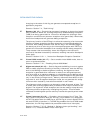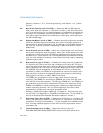
2-18 Vol. 3
SYSTEM ARCHITECTURE OVERVIEW
• The MOV CRn instructions do not check that addresses written to CR2 and CR3
are within the linear-address or physical-address limitations of the implemen-
tation.
• Register CR8 is available in 64-bit mode only.
The control registers are summarized below, and each architecturally defined control
field in these control registers are described individually. In Figure 2-6, the width of
the register in 64-bit mode is indicated in parenthesis (except for CR0).
• CR0 — Contains system control flags that control operating mode and states of
the processor.
• CR1 — Reserved.
• CR2 — Contains the page-fault linear address (the linear address that caused a
page fault).
• CR3 — Contains the physical address of the base of the paging-structure
hierarchy and two flags (PCD and PWT). Only the most-significant bits (less the
lower 12 bits) of the base address are specified; the lower 12 bits of the address
are assumed to be 0. The first paging structure must thus be aligned to a page
(4-KByte) boundary. The PCD and PWT flags control caching of that paging
structure in the processor’s internal data caches (they do not control TLB caching
of page-directory information).
When using the physical address extension, the CR3 register contains the base
address of the page-directory-pointer table In IA-32e mode, the CR3 register
contains the base address of the PML4 table.
See also: Chapter 4, “Paging.”
• CR4 — Contains a group of flags that enable several architectural extensions,
and indicate operating system or executive support for specific processor capabil-
ities. The control registers can be read and loaded (or modified) using the move-
to-or-from-control-registers forms of the MOV instruction. In protected mode,
the MOV instructions allow the control registers to be read or loaded (at privilege
level 0 only). This restriction means that application programs or operating-
system procedures (running at privilege levels 1, 2, or 3) are prevented from
reading or loading the control registers.
• CR8 — Provides read and write access to the Task Priority Register (TPR). It
specifies the priority threshold value that operating systems use to control the
priority class of external interrupts allowed to interrupt the processor. This
register is available only in 64-bit mode. However, interrupt filtering continues to
apply in compatibility mode.


















